Evaluating Quality Improvement Strategies for the NHS Program
VerifiedAdded on 2022/11/09
|5
|1010
|283
Report
AI Summary
This report provides an analysis of the NHS Quality Improvement program, focusing on the Quality and Outcomes Framework (QOF) introduced in 2004. It examines the process of auditing general practitioners to enhance the quality of care services, including clinical appraisals, patient experiences, and other patient welfare services. The report discusses key considerations for quality improvement, such as the audit environment, methods, and the development of QOF indicators. It highlights strengths like administrative support and collaboration among stakeholders, while also addressing weaknesses like financial constraints and organizational inertia. The report emphasizes the importance of a synergistic approach involving all care users and the need for honesty, transparency, and objective analysis to establish achievable and cost-effective quality improvement indicators, ultimately aimed at improving patient safety and the quality of services. The provided case study also explores the financial aspects and transparency concerns surrounding the QOF.
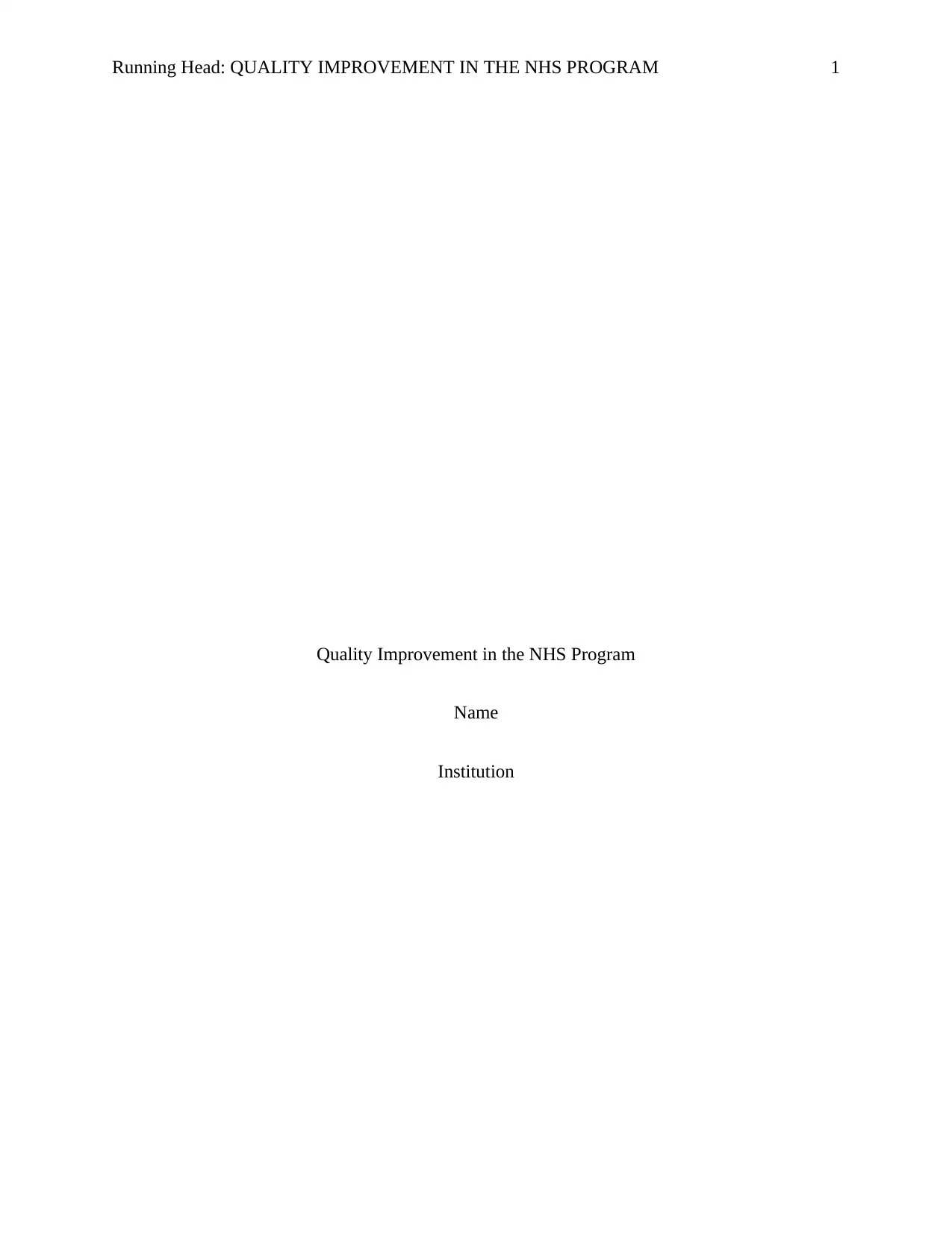
Running Head: QUALITY IMPROVEMENT IN THE NHS PROGRAM 1
Quality Improvement in the NHS Program
Name
Institution
Quality Improvement in the NHS Program
Name
Institution
Paraphrase This Document
Need a fresh take? Get an instant paraphrase of this document with our AI Paraphraser
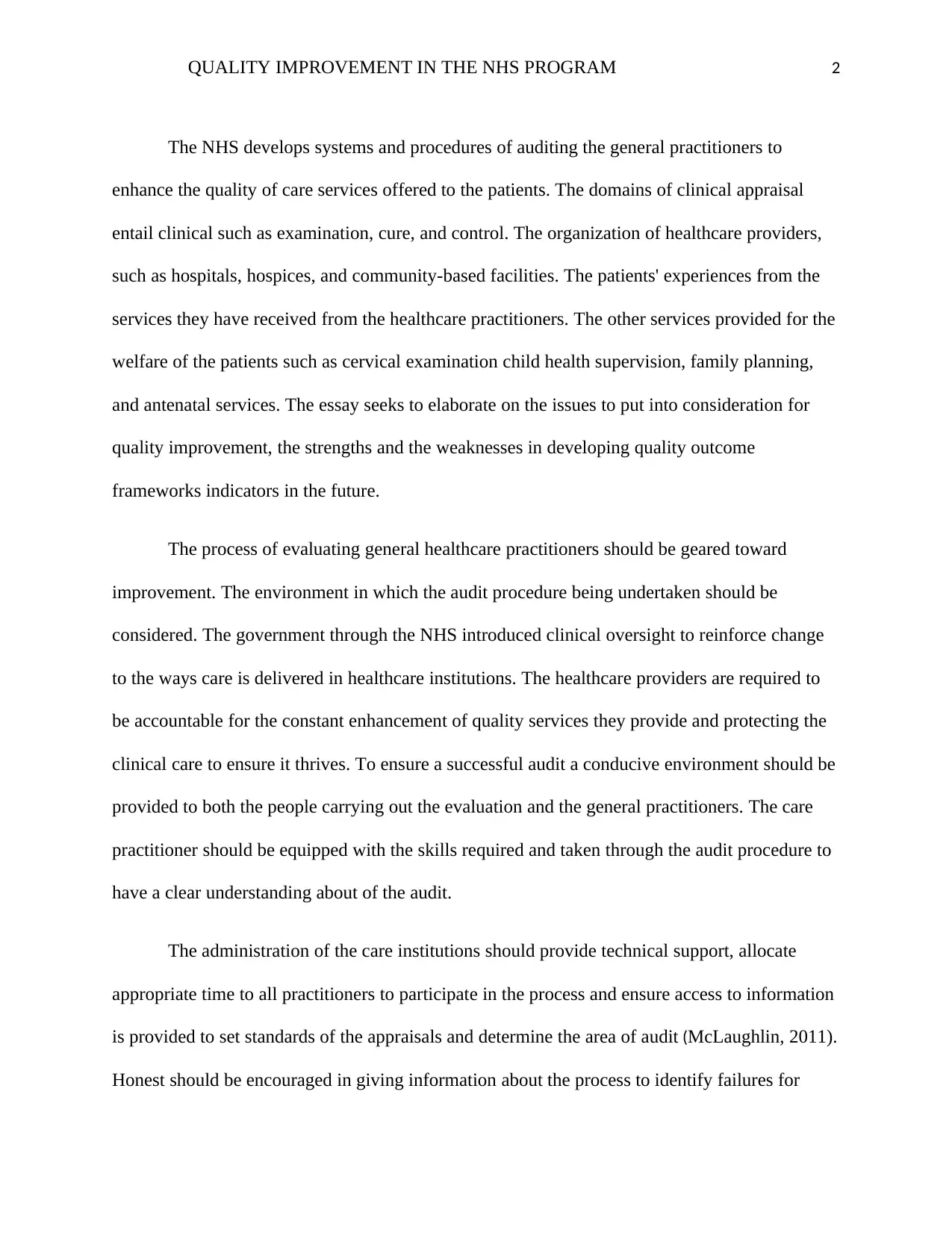
QUALITY IMPROVEMENT IN THE NHS PROGRAM 2
The NHS develops systems and procedures of auditing the general practitioners to
enhance the quality of care services offered to the patients. The domains of clinical appraisal
entail clinical such as examination, cure, and control. The organization of healthcare providers,
such as hospitals, hospices, and community-based facilities. The patients' experiences from the
services they have received from the healthcare practitioners. The other services provided for the
welfare of the patients such as cervical examination child health supervision, family planning,
and antenatal services. The essay seeks to elaborate on the issues to put into consideration for
quality improvement, the strengths and the weaknesses in developing quality outcome
frameworks indicators in the future.
The process of evaluating general healthcare practitioners should be geared toward
improvement. The environment in which the audit procedure being undertaken should be
considered. The government through the NHS introduced clinical oversight to reinforce change
to the ways care is delivered in healthcare institutions. The healthcare providers are required to
be accountable for the constant enhancement of quality services they provide and protecting the
clinical care to ensure it thrives. To ensure a successful audit a conducive environment should be
provided to both the people carrying out the evaluation and the general practitioners. The care
practitioner should be equipped with the skills required and taken through the audit procedure to
have a clear understanding about of the audit.
The administration of the care institutions should provide technical support, allocate
appropriate time to all practitioners to participate in the process and ensure access to information
is provided to set standards of the appraisals and determine the area of audit (McLaughlin, 2011).
Honest should be encouraged in giving information about the process to identify failures for
The NHS develops systems and procedures of auditing the general practitioners to
enhance the quality of care services offered to the patients. The domains of clinical appraisal
entail clinical such as examination, cure, and control. The organization of healthcare providers,
such as hospitals, hospices, and community-based facilities. The patients' experiences from the
services they have received from the healthcare practitioners. The other services provided for the
welfare of the patients such as cervical examination child health supervision, family planning,
and antenatal services. The essay seeks to elaborate on the issues to put into consideration for
quality improvement, the strengths and the weaknesses in developing quality outcome
frameworks indicators in the future.
The process of evaluating general healthcare practitioners should be geared toward
improvement. The environment in which the audit procedure being undertaken should be
considered. The government through the NHS introduced clinical oversight to reinforce change
to the ways care is delivered in healthcare institutions. The healthcare providers are required to
be accountable for the constant enhancement of quality services they provide and protecting the
clinical care to ensure it thrives. To ensure a successful audit a conducive environment should be
provided to both the people carrying out the evaluation and the general practitioners. The care
practitioner should be equipped with the skills required and taken through the audit procedure to
have a clear understanding about of the audit.
The administration of the care institutions should provide technical support, allocate
appropriate time to all practitioners to participate in the process and ensure access to information
is provided to set standards of the appraisals and determine the area of audit (McLaughlin, 2011).
Honest should be encouraged in giving information about the process to identify failures for
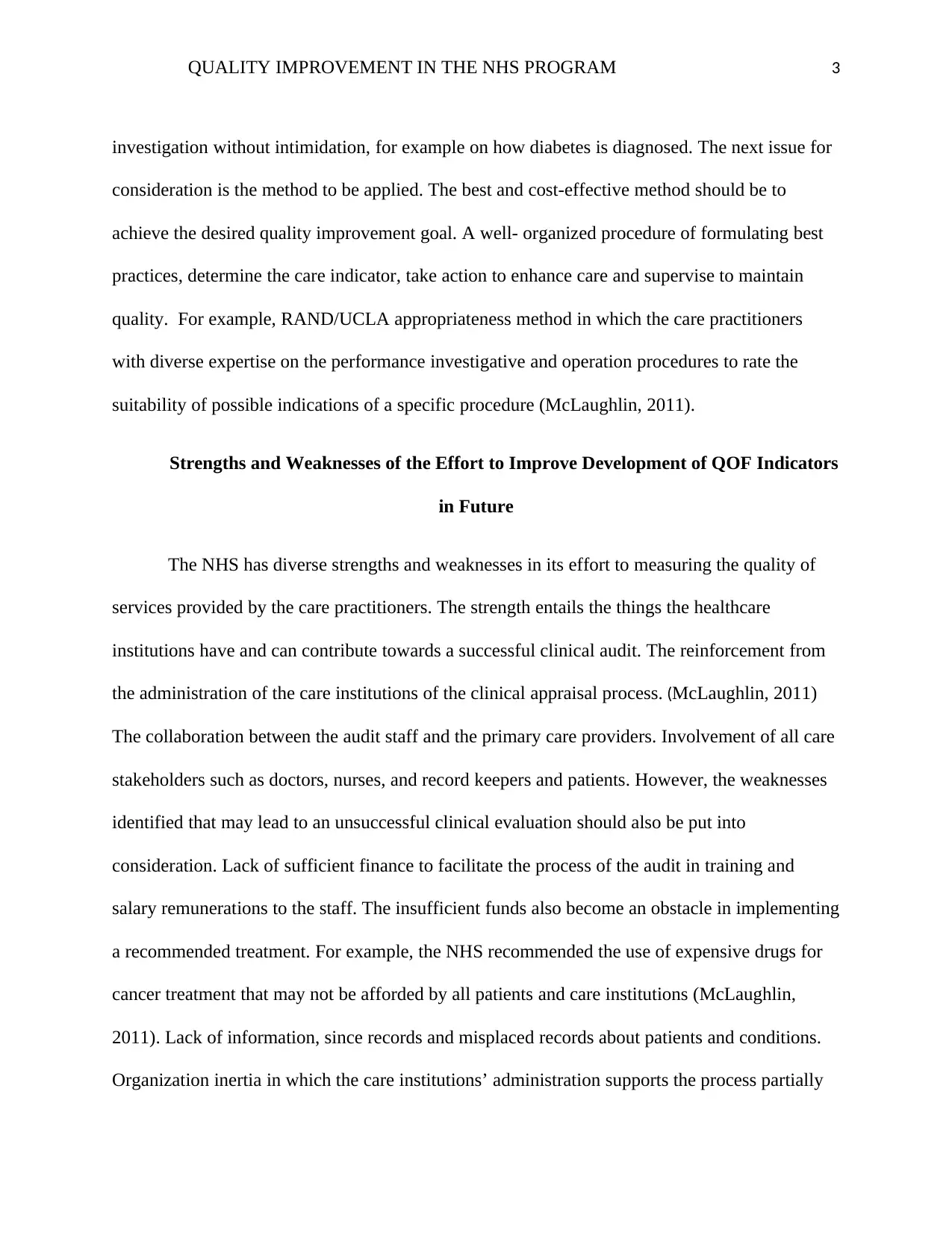
QUALITY IMPROVEMENT IN THE NHS PROGRAM 3
investigation without intimidation, for example on how diabetes is diagnosed. The next issue for
consideration is the method to be applied. The best and cost-effective method should be to
achieve the desired quality improvement goal. A well- organized procedure of formulating best
practices, determine the care indicator, take action to enhance care and supervise to maintain
quality. For example, RAND/UCLA appropriateness method in which the care practitioners
with diverse expertise on the performance investigative and operation procedures to rate the
suitability of possible indications of a specific procedure (McLaughlin, 2011).
Strengths and Weaknesses of the Effort to Improve Development of QOF Indicators
in Future
The NHS has diverse strengths and weaknesses in its effort to measuring the quality of
services provided by the care practitioners. The strength entails the things the healthcare
institutions have and can contribute towards a successful clinical audit. The reinforcement from
the administration of the care institutions of the clinical appraisal process. (McLaughlin, 2011)
The collaboration between the audit staff and the primary care providers. Involvement of all care
stakeholders such as doctors, nurses, and record keepers and patients. However, the weaknesses
identified that may lead to an unsuccessful clinical evaluation should also be put into
consideration. Lack of sufficient finance to facilitate the process of the audit in training and
salary remunerations to the staff. The insufficient funds also become an obstacle in implementing
a recommended treatment. For example, the NHS recommended the use of expensive drugs for
cancer treatment that may not be afforded by all patients and care institutions (McLaughlin,
2011). Lack of information, since records and misplaced records about patients and conditions.
Organization inertia in which the care institutions’ administration supports the process partially
investigation without intimidation, for example on how diabetes is diagnosed. The next issue for
consideration is the method to be applied. The best and cost-effective method should be to
achieve the desired quality improvement goal. A well- organized procedure of formulating best
practices, determine the care indicator, take action to enhance care and supervise to maintain
quality. For example, RAND/UCLA appropriateness method in which the care practitioners
with diverse expertise on the performance investigative and operation procedures to rate the
suitability of possible indications of a specific procedure (McLaughlin, 2011).
Strengths and Weaknesses of the Effort to Improve Development of QOF Indicators
in Future
The NHS has diverse strengths and weaknesses in its effort to measuring the quality of
services provided by the care practitioners. The strength entails the things the healthcare
institutions have and can contribute towards a successful clinical audit. The reinforcement from
the administration of the care institutions of the clinical appraisal process. (McLaughlin, 2011)
The collaboration between the audit staff and the primary care providers. Involvement of all care
stakeholders such as doctors, nurses, and record keepers and patients. However, the weaknesses
identified that may lead to an unsuccessful clinical evaluation should also be put into
consideration. Lack of sufficient finance to facilitate the process of the audit in training and
salary remunerations to the staff. The insufficient funds also become an obstacle in implementing
a recommended treatment. For example, the NHS recommended the use of expensive drugs for
cancer treatment that may not be afforded by all patients and care institutions (McLaughlin,
2011). Lack of information, since records and misplaced records about patients and conditions.
Organization inertia in which the care institutions’ administration supports the process partially
⊘ This is a preview!⊘
Do you want full access?
Subscribe today to unlock all pages.

Trusted by 1+ million students worldwide
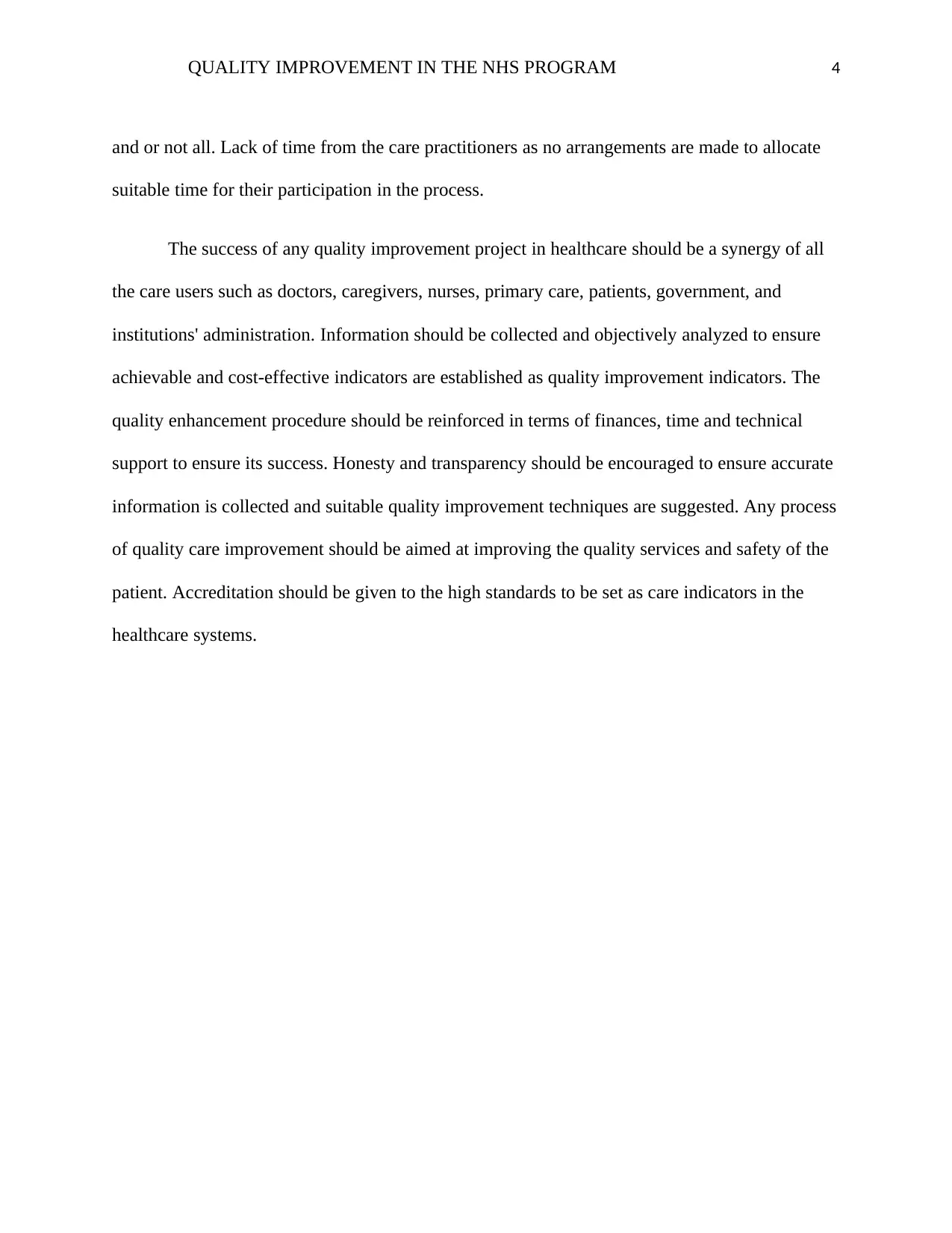
QUALITY IMPROVEMENT IN THE NHS PROGRAM 4
and or not all. Lack of time from the care practitioners as no arrangements are made to allocate
suitable time for their participation in the process.
The success of any quality improvement project in healthcare should be a synergy of all
the care users such as doctors, caregivers, nurses, primary care, patients, government, and
institutions' administration. Information should be collected and objectively analyzed to ensure
achievable and cost-effective indicators are established as quality improvement indicators. The
quality enhancement procedure should be reinforced in terms of finances, time and technical
support to ensure its success. Honesty and transparency should be encouraged to ensure accurate
information is collected and suitable quality improvement techniques are suggested. Any process
of quality care improvement should be aimed at improving the quality services and safety of the
patient. Accreditation should be given to the high standards to be set as care indicators in the
healthcare systems.
and or not all. Lack of time from the care practitioners as no arrangements are made to allocate
suitable time for their participation in the process.
The success of any quality improvement project in healthcare should be a synergy of all
the care users such as doctors, caregivers, nurses, primary care, patients, government, and
institutions' administration. Information should be collected and objectively analyzed to ensure
achievable and cost-effective indicators are established as quality improvement indicators. The
quality enhancement procedure should be reinforced in terms of finances, time and technical
support to ensure its success. Honesty and transparency should be encouraged to ensure accurate
information is collected and suitable quality improvement techniques are suggested. Any process
of quality care improvement should be aimed at improving the quality services and safety of the
patient. Accreditation should be given to the high standards to be set as care indicators in the
healthcare systems.
Paraphrase This Document
Need a fresh take? Get an instant paraphrase of this document with our AI Paraphraser
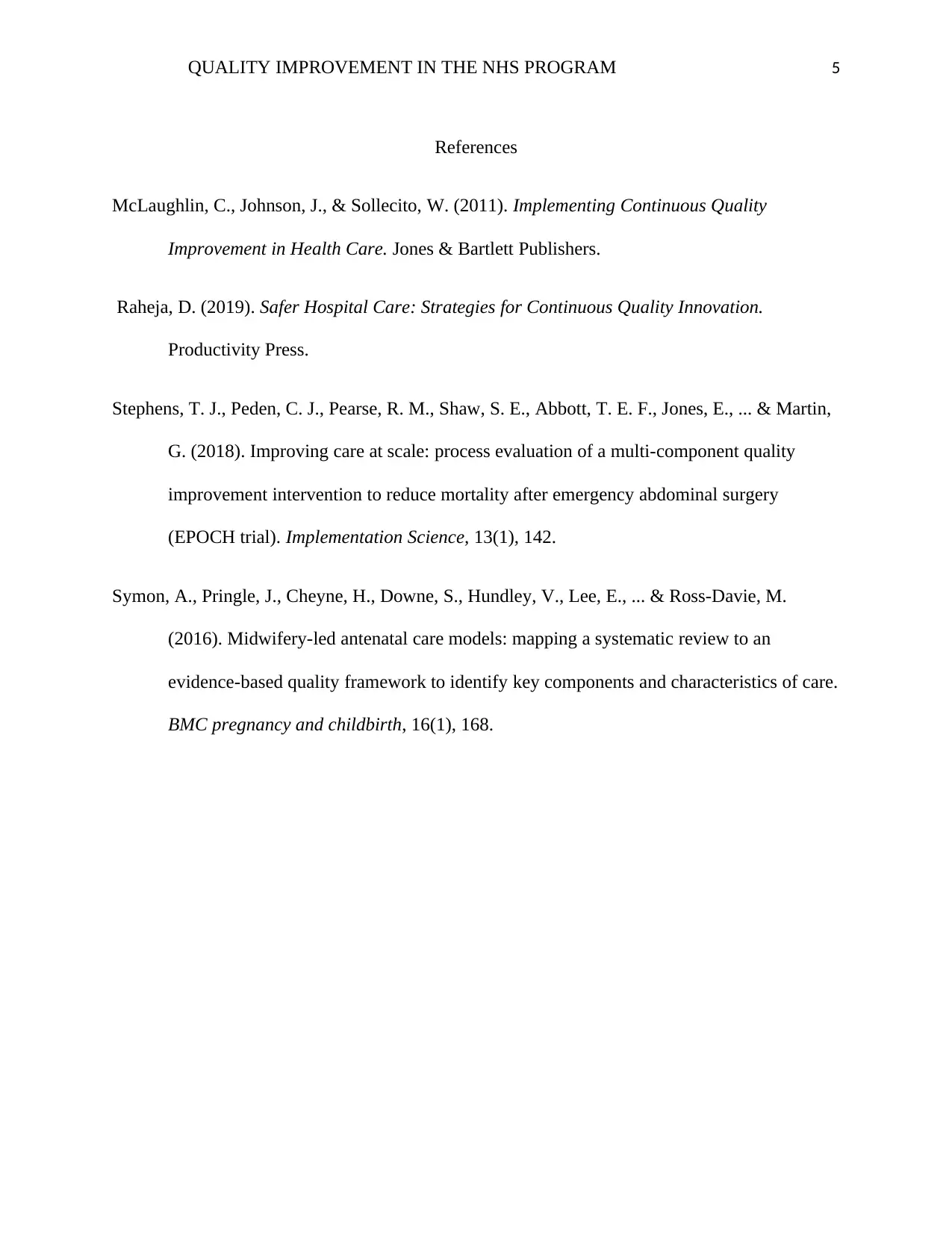
QUALITY IMPROVEMENT IN THE NHS PROGRAM 5
References
McLaughlin, C., Johnson, J., & Sollecito, W. (2011). Implementing Continuous Quality
Improvement in Health Care. Jones & Bartlett Publishers.
Raheja, D. (2019). Safer Hospital Care: Strategies for Continuous Quality Innovation.
Productivity Press.
Stephens, T. J., Peden, C. J., Pearse, R. M., Shaw, S. E., Abbott, T. E. F., Jones, E., ... & Martin,
G. (2018). Improving care at scale: process evaluation of a multi-component quality
improvement intervention to reduce mortality after emergency abdominal surgery
(EPOCH trial). Implementation Science, 13(1), 142.
Symon, A., Pringle, J., Cheyne, H., Downe, S., Hundley, V., Lee, E., ... & Ross-Davie, M.
(2016). Midwifery-led antenatal care models: mapping a systematic review to an
evidence-based quality framework to identify key components and characteristics of care.
BMC pregnancy and childbirth, 16(1), 168.
References
McLaughlin, C., Johnson, J., & Sollecito, W. (2011). Implementing Continuous Quality
Improvement in Health Care. Jones & Bartlett Publishers.
Raheja, D. (2019). Safer Hospital Care: Strategies for Continuous Quality Innovation.
Productivity Press.
Stephens, T. J., Peden, C. J., Pearse, R. M., Shaw, S. E., Abbott, T. E. F., Jones, E., ... & Martin,
G. (2018). Improving care at scale: process evaluation of a multi-component quality
improvement intervention to reduce mortality after emergency abdominal surgery
(EPOCH trial). Implementation Science, 13(1), 142.
Symon, A., Pringle, J., Cheyne, H., Downe, S., Hundley, V., Lee, E., ... & Ross-Davie, M.
(2016). Midwifery-led antenatal care models: mapping a systematic review to an
evidence-based quality framework to identify key components and characteristics of care.
BMC pregnancy and childbirth, 16(1), 168.
1 out of 5
Related Documents
Your All-in-One AI-Powered Toolkit for Academic Success.
+13062052269
info@desklib.com
Available 24*7 on WhatsApp / Email
![[object Object]](/_next/static/media/star-bottom.7253800d.svg)
Unlock your academic potential
Copyright © 2020–2025 A2Z Services. All Rights Reserved. Developed and managed by ZUCOL.





